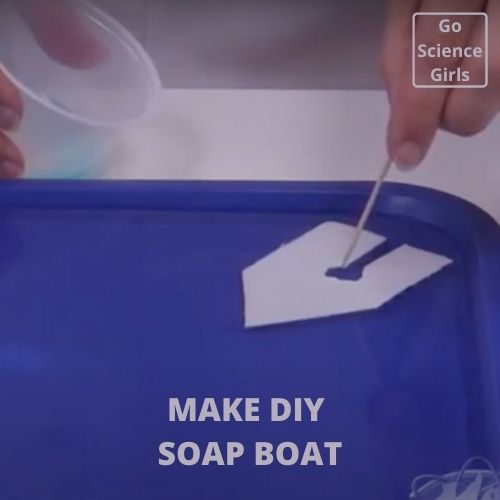This science activity video on a soap boat experiment is about the surface tension of water and the effect of soap on it. The video is presented by none another than the famous British presenter Rufus Hound and his son Alby.
Courtesy: The Royal Institution
Have you ever noticed rainwater forming beads on leaves? These beautiful beads look just like sparkling pearls. Do you know why this happens? How the water gets clustered into a bead? Well, this happens because of the surface tension. This is one of the tendencies of liquid surfaces. Here, it is essential to remember that water has high surface tension. The reason is the existence of relatively strong hydrogen bonds by which water molecules hold into each other. However, the application of other liquids like soap can make this surface tension weak. To understand how this works, let’s do this super fun soap water experiment!
How to make a soap powered model boat?

Take a styrofoam plate and a pair of scissors. Now, draw the shape on the plate as it is shown in the figure with a pencil. Cut it out with a small notch so that you have a flat piece of styrofoam that can float on water and your soap powered boat is ready to go!! You can also take an empty juice carton instead of a styrofoam plate to make the soap powered model boat.
Steps of the soap water boat experiment
.
Raw materials
1 Baking tray
1 Ice cube tray
A few cotton buds
1 soap powered boat model
Range of household liquids
Steps to follow

- First, fill the baking tray with some water.
- Now fill the different compartments of the ice cube dray with different liquids, such as cooking oil, vinegar, shampoo, conditioner, liquid hand soap, and so on.
- Next, take the boat model and place it gently on the water, which is in the baking tray.
- Take the cotton bud and dip it into the hand liquid soap compartment of the ice cube tray.
- Now, touch the tip of the cotton bud into the water in the notch of your boat. Your boat will start moving swiftly.
- You can experiment with different liquids to know whether the same happens in the case of each liquid or not.
Observation
You will observe that when you put a little soap into the water in the notch, it weakens the surface tension of the water. This creates enough force that ultimately pushes the lightweight boat forward with speed. Now, you must be curious to know how a little amount of soap liquid manages to do the same.
How soap reduces the surface tension of water?
Soaps have molecules having dual nature. While at one end, they love water, at the other end, they are hydrophobic or get repelled by water. Thus, when soap comes in contact with water, it pushes the water molecules with its hydrophobic end and weakens the hydrogen bonds of each water molecule. In this way, it reduces the surface tension of water. You can witness the same at home. Just take a shallow dish filled with water and add some dried oregano. Now take a cotton bud and dip its tip in some liquid soap. Dip it into the middle of the shallow dish, and you will clearly observe that as the
soap spreads out on the water surface, it pushes the water away and also pushes the oregano flakes along with water.
This amazing video of the soap boat water experiment gives a deep insight into surface tension. Also, the way soap impacts the surface tension of water. So, the next time when you spot water striders walking on water, don’t get surprised. This is all because of their ability to leverage the surface tension of water to their advantage!
Resource
https://www.rigb.org/docs/rufusracers_infosheet_0.pdf
https://www.biolinscientific.com/measurements/surface-tension
